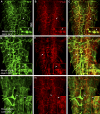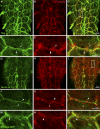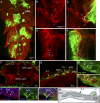The Drosophila blood brain barrier is maintained by GPCR-dependent dynamic actin structures
- PMID: 21242289
- PMCID: PMC3172179
- DOI: 10.1083/jcb.201007095
The Drosophila blood brain barrier is maintained by GPCR-dependent dynamic actin structures
Abstract
The blood brain barrier (BBB) is essential for insulation of the nervous system from the surrounding environment. In Drosophila melanogaster, the BBB is maintained by septate junctions formed between subperineurial glia (SPG) and requires the Moody/G protein-coupled receptor (GPCR) signaling pathway. In this study, we describe novel specialized actin-rich structures (ARSs) that dynamically form along the lateral borders of the SPG cells. ARS formation and association with nonmuscle myosin is regulated by Moody/GPCR signaling and requires myosin activation. Consistently, an overlap between ARS localization, elevated Ca(2+) levels, and myosin light chain phosphorylation is detected. Disruption of the ARS by inhibition of the actin regulator Arp2/3 complex leads to abrogation of the BBB. Our results suggest a mechanism by which the Drosophila BBB is maintained by Moody/GPCR-dependent formation of ARSs, which is supported by myosin activation. The localization of the ARSs close to the septate junctions enables efficient sealing of membrane gaps formed during nerve cord growth.
Figures








Similar articles
-
The cAMP effector PKA mediates Moody GPCR signaling in Drosophila blood-brain barrier formation and maturation.Elife. 2021 Aug 12;10:e68275. doi: 10.7554/eLife.68275. Elife. 2021. PMID: 34382936 Free PMC article.
-
GPCR signaling is required for blood-brain barrier formation in drosophila.Cell. 2005 Oct 7;123(1):133-44. doi: 10.1016/j.cell.2005.08.037. Cell. 2005. PMID: 16213218
-
The Drosophila Blood-Brain Barrier Adapts to Cell Growth by Unfolding of Pre-existing Septate Junctions.Dev Cell. 2018 Dec 17;47(6):697-710.e3. doi: 10.1016/j.devcel.2018.10.002. Epub 2018 Oct 25. Dev Cell. 2018. PMID: 30482667
-
The blood-brain barrier--lessons from moody flies.Cell. 2005 Oct 7;123(1):9-12. doi: 10.1016/j.cell.2005.09.017. Cell. 2005. PMID: 16213208 Review.
-
Molecular dissection of smooth septate junctions: understanding their roles in arthropod physiology.Ann N Y Acad Sci. 2017 Jun;1397(1):17-24. doi: 10.1111/nyas.13366. Ann N Y Acad Sci. 2017. PMID: 28636800 Review.
Cited by
-
Ena orchestrates remodelling within the actin cytoskeleton to drive robust Drosophila macrophage chemotaxis.J Cell Sci. 2019 Feb 18;132(5):jcs224618. doi: 10.1242/jcs.224618. J Cell Sci. 2019. PMID: 30718364 Free PMC article.
-
The Drosophila blood-brain barrier invades the nervous system in a GPCR-dependent manner.Front Cell Neurosci. 2024 May 23;18:1397627. doi: 10.3389/fncel.2024.1397627. eCollection 2024. Front Cell Neurosci. 2024. PMID: 38846639 Free PMC article.
-
Arp2/3-mediated F-actin formation controls regulated exocytosis in vivo.Nat Commun. 2015 Dec 7;6:10098. doi: 10.1038/ncomms10098. Nat Commun. 2015. PMID: 26639106 Free PMC article.
-
Direct interaction of avermectin with epidermal growth factor receptor mediates the penetration resistance in Drosophila larvae.Open Biol. 2016 Apr;6(4):150231. doi: 10.1098/rsob.150231. Epub 2016 Apr 13. Open Biol. 2016. PMID: 27249340 Free PMC article.
-
Barrier mechanisms in the Drosophila blood-brain barrier.Front Neurosci. 2014 Dec 16;8:414. doi: 10.3389/fnins.2014.00414. eCollection 2014. Front Neurosci. 2014. PMID: 25565944 Free PMC article. Review.
References
Publication types
MeSH terms
Substances
LinkOut - more resources
Full Text Sources
Other Literature Sources
Molecular Biology Databases
Miscellaneous

